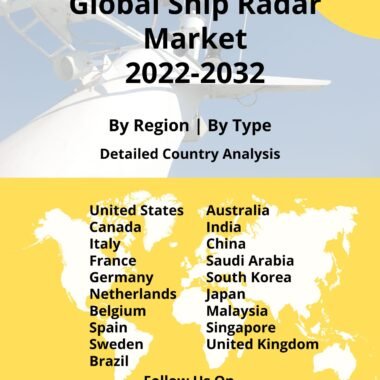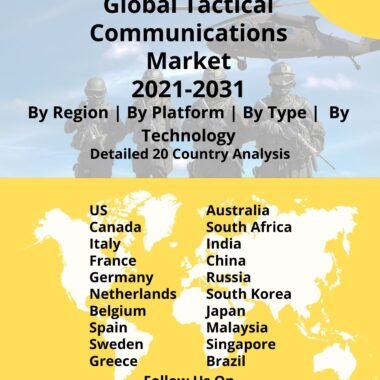Description
Global Defense Secured Communication Market
Frequently Asked Questions of Defense Secured Communication Market
Defense-secured communication is defined as the measures taken to prevent any unauthorized access to any information derived from telecommunications traffic or textual information that is transmitted via military communications networks.
The defense secure communication includes emission security, cryptographic security, physical security, and transmission security. Cryptographic security aids in the encryption of data, making it unreadable until it is decrypted. To prevent unwanted interception of information, emission security prohibits the release or capture of device emanations. Physical security safeguards the safety of a network’s cryptographic information, documents, and equipment while also preventing illegal access. Transmission security prevents concerns by protecting the network when data is physically transported.
Major factors driving Defense Secured Communication Market Growth
Protecting highly confidential information and establishing constant communication are two important criteria for the military industry. Citizens’ safety may be at risk, and international wars may start if sensitive data is not adequately safeguarded and if real-time data is not successfully conveyed. To acquire cutting-edge defense and secure communication technologies that permit precise, covert, and secure data transfer in real-time, significant military investments are being made in these fields.
Trends influencing the Defense Secured Communication Market Size
Two major variables that are anticipated to speed up the expansion of this market are the ongoing hostilities between various countries and the rising border tensions among Asian countries. Tensions along the Indo-China border are predicted to increase defense spending in both of these developing countries. For instance, a proposal for USD 104.6 crore was sent to the Indian Army to secure a stronger communication network in operational scenarios as per defense secured communications market analysis.
The Indian Army claimed that it had created and deployed its encrypted texting program in October 2020. The smartphone messaging and communication app Secure Application for the Internet (SAI) will be utilized for corporate communications. End-to-end encryption is used in this smartphone app, which is presently only accessible on Android devices, to protect all forms of communication, including texts, voicemails, and video chats. According to the Ministry of Defence, the SAI app has a modular code foundation that can be modified to meet the specific requirements of India’s armed forces, and all data would be sent over local, internal data servers.
Defense Secured Communication Forecast & Dynamics
The battlefield of today is changing at a faster rate than ever before. Armed forces and munitions are all networked and have turned the front line into a digital arsenal. Increased digitalization brings both benefits and risks. As no risk cannot be afforded, the defense and military sector is increasingly investing in securing their communication networks.
The increased geo-political conflicts within the Indo-Pacific region make it a lucrative market for secure defense communication devices. Moreover, China has been trying to establish a strong foothold in the telecommunication devices market through the proliferation of brands like Huawei. Several consumer concerns regarding data privacy and safety are poised to be one of the key factors that lead to increased adoption of secured communication systems across global markets.
Defense Secured Communication Analysis for Recent Developments
The overarching concept of Joint All-Domain Command and Control (JADC2) and its guidelines are expected to drive the investment associated with defense-secured communications. It is noted that the need for increased communications between various platforms is driving the Air Force (ABMS), Army (Project Convergence), and Navy (Project Overmatch) to work on their demonstrations and initial concepts to meet the joint requirements. To develop a uniform command and control system across troops, all means of communication, as well as software-defined networking and overall network management, will play a part. To make this all come together, industry cooperation will be crucial.
In 2021, The Dutch Ministry of Defense entered into a definitive agreement with the communication security provider, Sectra for secure communications. The new framework agreement includes the latest version of Sectra’s Sectra Tiger/S, 7401 LTE. The solution permits the Dutch Ministry of Defense users to transmit confidential information safely and securely from anywhere and at any time.
The global landscape of defense secured communication has seen substantial advancements, reflecting the critical importance of secure and resilient communication in military operations. Defense secured communication encompasses a range of technologies and protocols designed to protect military communications from unauthorized access, interception, and cyber threats. Advancements in defense secured communication include the development of sophisticated encryption algorithms, secure network architectures, and anti-jamming technologies. These enhancements ensure the confidentiality, integrity, and availability of sensitive military information in the face of evolving cybersecurity challenges.
The integration of secure communication protocols into various defense platforms, including land, sea, air, and space systems, supports seamless and encrypted information exchange across the entire spectrum of military operations. Global defense forces emphasize interoperability and standardization to facilitate secure communication among allied nations and coalition partners. Collaborative efforts aim to establish common standards and practices to enhance the effectiveness of joint military operations. The ongoing evolution of defense-secured communication in 2023 underscores a commitment to staying ahead of cybersecurity threats, ensuring mission success, and safeguarding sensitive military information in an increasingly interconnected and digitized defense environment.







